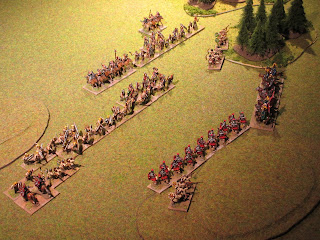That evening, in the Carthaginian camp, the generals
and key officers made plans to resume battle the following morning. The novel
tactic of shifting the Numidians from one flank to the other would no longer
catch the Romans on the wrong foot, so it was decided to form all the cavalry
to the right wing. This would noticeably shorten the main battleline and to
compensate for this light infantry were interspersed between the auxiliaries
and spearmen. This was a risky deployment, but everyone had to do their part.
As was the custom for consuls taking the field, overall
command alternated between the two and for next day the commander of the left flank
now made plans. The dense deployment of the previous day would be replaced by a
longer line bringing the hastati and principes to face the Carthaginian
spearmen. To achieve this, the triarii would take a central position in the
main battleline. To take care of an enemy approach on the open side (left
flank), a reserve of cavalry and velites would form a second line; these would have
the task of neutralising the enemy cavalry operating on that side.
The tension was further heightened when a thunderstorm
broke during the night bringing with it a downpour of rain; this would make the
fields in the area rough going. This was viewed as a good omen by the
soothsayer ensuring the Roman command of victory in the morning.
Battle
Marching out of their camp, Rome deployed its legions
to the plan. On the left flank, a second line positioned itself to hold off any
cavalry attempting to encircle the Roman battleline.
The Carthaginian infantry deployed in the same
formation as the day before, Spanish auxiliaries and Gallic warriors in the centre
with Poeni and Libyan spearmen anchoring both flanks. On the far right flank all
the cavalry formed up eager to come to grips with Roman cavalry.
Rome moved first and during the approach both legions
were plagued by mixed or missed signals (low pip scores) and as a consequence
the approach took on an oblique order. This actually worked in their favour as
the Carthaginian cavalry swept quickly around the left flank.
As the Roman infantry were slowing closing on the
Carthaginian battleline, the Poeni spearmen were seen retiring; this smelled of
treachery. Due to the slow approach on the left, the reserve line with the
assistance of Allied auxiliaries was able to blunt the cavalry threat.
By now, the entire legion on the right was fully engaged
and meeting stiff resistance from the Spanish and Gallic troops. Further to the
far right, the Allied auxiliaries were making no headway against the Poeni
shield wall.
Having made their approach in a staggered formation the
hastati and principes were now able to join the battle. These sent the Spanish
and Gallic troops recoiling, but the effect brought no casualties; this would seem
to be developing into a long hard battle. On the far left, the Carthaginian
cavalry were held back with the additional help of a unit of hastati.
Signal horns were heard and repeated along the
Carthaginian line announcing a general assault and both groups of spearmen
moved into combat. On hearing the signal, the cavalry renewed their attack.
Repeated assaults by the cavalry had cost them dearly
bringing their losses just short of demoralisation. It was then decided to have
the cavalry fall back and regroup. At this moment cheering could be heard
coming from the infantry battle and through the dust could be seen a line of
white shields marching forward – the Poeni spearmen. Through the combined effort
of the spearmen with the Spanish and Gallic troops, the Roman left wing was
shattered leaving the right wing to carry on with the battle.
The Roman right was now in a desperate situation as
they had suffered significant casualties while the Carthaginian battle line
remained unbroken. In a desperate attempt to turn the battle around, the Roman
commander and Allied cavalry charged forward.
A sense of doom gripped the Roman troops as the left
wing could only look on as the Numidian light horse skirted their line to approach
the rear of the Roman troops on the right. Unfortunately for the Numidians, they
were denied their moment of glory as the Spanish and Gallic troops broke the remaining
legion sending them fleeing in the direction of their camp.
The Carthaginian commander, sitting on his camp stool
(CP) accepted the accolades from his companions for the decisive victory over
Rome.
Epilogue
The Carthaginian cavalry had fallen short of their
objective, but history of course would present a different story. In effect,
the threat did draw off needed Roman troops including the C-in-C that could
have proven valuable elsewhere. The C-in-C’s command had suffered three
casualties bring his command one short of becoming demoralised; all these came
from the cavalry and its supporting light infantry.
The second command, which took the brunt of the Roman
assault were able to break one legion and assist breaking a second and all this
while suffering no casualties. If the thunderstorm was interpreted as a good
omen, then it was obviously meant for the opposition. Needless to say, that soothsayer has made his last divination.






































